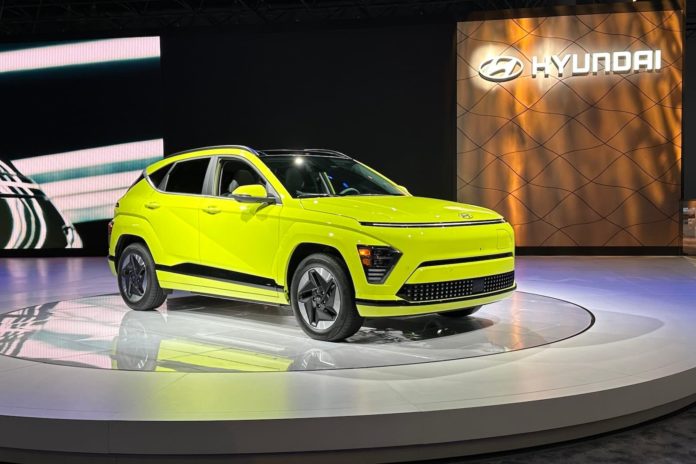You might think of the Hyundai Kona as three vehicles in one. There’s the affordable subcompact crossover, the sporty N Line model and the all-electric CUV. In all it’s various forms, the 2024 Hyundai Kona made its official debut at the New York International Auto Show on Tuesday.
Not that it was a complete secret. The South Korean carmaker gave a sneak peek at the crossover barely a month ago during a media webcast. And it showed that the little Kona has undergone some big changes. Among other things, it’s grown as much as 7 inches longer, with a cabin that’s not only roomier but markedly upgraded.
All versions of the Kona add new tech features, and the EV version gets a larger battery pack delivering slightly more range. Curiously, while horsepower is up, the all-electric model does sacrifice some torque.
“The all-new Kona and Kona Electric continue to build upon our extremely successful first-generation model, with outstanding efficiency, innovative technologies, distinctive styling, and comprehensive safety features,” said José Muñoz, president and CEO, Hyundai Motor North America.
All-new platform

Hyundai is betting big on electric vehicle technology and its new Ioniq 6 is just starting to roll into U.S. showrooms. Both that model and the earlier Ioniq 5 are based of the E-GMP “architecture,” a platform specifically designed to be used solely by all-electric vehicles.
Kona, however, is offered with a choice of both an internal combustion driveline and an all-electric one. With this second-generation crossover, however, Hyundai said it took an “unconventional” approach.
It “developed the new Kona platform with an electrified powertrain first,” the carmaker said in a statement, “in line with the company’s accelerated electrification strategy announcement that will bring 11 new Hyundai EVs to market globally by 2030.”
That approach helped minimize any intrusion by the battery pack into passenger and cargo space and also lowered the EV version’s center of gravity, a benefit in terms of ride and handling.

Kona Electric
Kona Electric is available with two battery pack choices. That includes a “standard” range offering of 48.6 kilowatt-hours that makes an EPA-estimated 197 miles per charge. The extended-range lithium-ion pack bumps that up to 64.8 kWh — 1.4 kWh more than the outgoing model — and gets 260 miles per charge.
Unlike the new Ioniq 5 and 6 models, Kona EV only can charge at power ratings up to 400 volts. Even then, the longer-range version of the crossover can go from a 10% to 80% state-of-charge using a DC quick charger in 43 minutes.
Motorists will be able to tap into the battery using a Vehicle-to-Load, or V2L system that could be used at a work or campsite, or to keep appliance running at home or office in the event of a blackout.
Both versions of the EV rely on a single electric motor driving the front axle. The base Kona Electric makes 133 horsepower. With the extended-range battery that rises to 201 hp, but both versions make just 188 pound-feet of torque. Previously, torque was as high as 291 lb-ft.

Kona and Kona N Line
The Kona Electric is about 6 inches longer than the outgoing model, as is the base, gas-powered version. The sportier N Line adds another inch, with an overall length of 172.6 inches.
There are two gas powertrain options:
- The base car is powered by a 2.0-liter 4-cylinder Atkinson cycle engine makes 147 hp and 132 lb-ft of torque. It’s paired with a continuously variable transmission;
- Both N Line and Limited models upgrade to a 1.6-liter turbocharged-4 bumping power up to 190 hp and 195 lb-ft. It’s mated to an 8-speed automatic gearbox.

Both models are offered with a choice of front- or all-wheel drive.
Longer, wider
All versions of the 2024 Hyundai Kona now feature a longer, 104.7-inch wheelbase, as well as shorter front and rear overhangs and a wider track.
Gas models get a MacPherson strut front suspension with coil springs and a hollow stabilizer bar. All-wheel-drive versions get a multi-link rear suspension, while front-wheel-drive packages get a torsion beam rear. The Kona Electric has a MacPherson strut suspension up front, with coil springs and a multi-link rear suspension.

Styling
Styling updates are modest — the most obvious difference with the 2024 model being the introduction of smaller, lower-mounted headlamps and the lightbar running atop the new Kona’s grille. This “Seamless horizon” design is mirrored by the 2024 model’s new taillight design.
There’ll be subtle differences depending upon trim. The body cladding is gray on all gas-powered models but the N Line picks up the body color cladding of the EVs. The N Line also adds a fairly aggressive two-piece rear spoiler.
Hyundai has upgraded the interior on all models with more tech and less hard plastic. In the case of the Kona Electric, it said, the instrument panel features “a floating horizontal C-Pad with integrated, dual 12.3-inch panoramic display screens.”

Kona N Line
The Kona N Line adds sport seating with red accents, aluminum sport pedals and other sporty interior details. It also gets 19-inch alloy wheels, an N Line rear spoiler, dual-outlet exhaust tips and wing-shaped front and rear fascia.
The 2024 Kona also introduces an expanded range of advanced driver assistance systems, in line with what Hyundai now is offering on other product lines.
Space and pricing
The automaker set out to address some of the key complaints about the first-generation Kona, notably the cramped cabin and cargo bay. The increased dimensions certainly help, as does the switch to front seats that are 30% thinner. With all seats upright, Hyundai claims cargo space jumps to 25.5 cubic feet. Fold the seats down and you’ll up that to 63.7 cf.
As for pricing, it should be released closer to the on-sale date during the third quarter of 2023.

